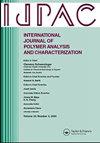叶片结构聚苯胺-二氧化钛复合材料对活性黑5染料有效光降解的优化
IF 1.6
4区 工程技术
Q4 POLYMER SCIENCE
International Journal of Polymer Analysis and Characterization
Pub Date : 2025-03-01
DOI:10.1080/1023666X.2025.2470221
引用次数: 0
摘要
纺织工业排放的有毒有机染料对水生生物造成了严重的影响,迫切需要一种有效的保护环境的处理方法。近年来,光催化因其环境友好性而受到广泛的研究,其中有害的有机化合物可以通过太阳能转化为二氧化碳和水。本研究利用具有叶片微纳米结构(L-PANI)的聚苯胺(PANI)与不同重量% (wt %)的二氧化钛(TiO2)组成复合材料,作为光催化剂用于活性黑5 (RB5)染料的光降解。结果表明,当TiO2含量为5 wt %、10 wt %、20 wt %和30 wt %时,L-PANI对RB5染料的光降解率分别为44.2%、48.8%、41.7%和35.5%。以L-PANI-TiO2 (10 wt %)为催化剂,在暗吸附时间为80 min,光反应时间为180 min, RB5初始浓度为10 ppm,光催化剂用量为25 mg的条件下,进一步研究了最佳光降解参数,光降解效率为98.2%。为了实现RB5染料的100%光降解,将光反应时间延长至210矿,使用25 mg L-PANI-TiO2 (10 wt %)光催化剂,将10 ppm的RB5染料成功地光降解至100%。这表明L-PANI-TiO2作为光降解RB5染料的有效光催化剂的潜力。本文章由计算机程序翻译,如有差异,请以英文原文为准。
The optimization of leaf-structured polyaniline-titanium dioxide composite toward effective photodegradation of reactive black 5 dyes
The discharge of toxic organic dye from textile industries causes concerning effects on aquatic life, and this raises the urgent need for an effective treatment method that can preserve the environment. Recently, photocatalysis has been widely studied due to its environmentally friendly nature in which hazardous organic compounds can be converted into carbon dioxide and water through solar energy. In this research, polyaniline (PANI) with a leaf micro/nanostructure (L-PANI) is used to form a composite with different weight % (wt %) of titanium dioxide (TiO2) to be used as a photocatalyst toward the photodegradation of Reactive Black 5 (RB5) dyes. Based on the results, L-PANI with 5 wt %, 10 wt %, 20 wt %, and 30 wt % of TiO2 showed photodegradation of 44.2%, 48.8%, 41.7%, and 35.5%, respectively toward RB5 dyes. The optimum photodegradation parameters were further studied using L-PANI-TiO2 (10 wt %), and it was found that a photodegradation efficiency of 98.2% is achieved with 80 min of dark adsorption time, 180 min of light reaction time, 10 ppm of initial RB5 dye concentration, and 25 mg of photocatalyst. To achieve 100% photodegradation of RB5 dye, the light reaction time was extended to 210 mines, and the 10 ppm of RB5 dye was successfully photodegraded to 100% using 25 mg of L-PANI-TiO2 (10 wt %) photocatalyst. This shows the potency of L-PANI-TiO2 as an effective photocatalyst toward the photodegradation of RB5 dye.
求助全文
通过发布文献求助,成功后即可免费获取论文全文。
去求助
来源期刊
CiteScore
3.50
自引率
5.30%
发文量
37
审稿时长
1.6 months
期刊介绍:
The scope of the journal is to publish original contributions and reviews on studies, methodologies, instrumentation, and applications involving the analysis and characterization of polymers and polymeric-based materials, including synthetic polymers, blends, composites, fibers, coatings, supramolecular structures, polysaccharides, and biopolymers. The Journal will accept papers and review articles on the following topics and research areas involving fundamental and applied studies of polymer analysis and characterization:
Characterization and analysis of new and existing polymers and polymeric-based materials.
Design and evaluation of analytical instrumentation and physical testing equipment.
Determination of molecular weight, size, conformation, branching, cross-linking, chemical structure, and sequence distribution.
Using separation, spectroscopic, and scattering techniques.
Surface characterization of polymeric materials.
Measurement of solution and bulk properties and behavior of polymers.
Studies involving structure-property-processing relationships, and polymer aging.
Analysis of oligomeric materials.
Analysis of polymer additives and decomposition products.

 求助内容:
求助内容: 应助结果提醒方式:
应助结果提醒方式:


